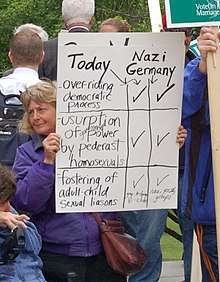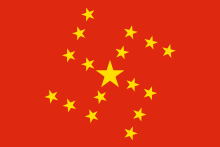Nazi analogies
Nazi analogies or Nazi comparisons are any comparisons or parallels which are related to Nazism or Nazi Germany, which often reference Adolf Hitler, Joseph Goebbels, the SS, or the Holocaust.[1] Despite criticism, such comparisons have been employed for a wide variety of reasons since Hitler's rise to power. Some Nazi comparisons are logical fallacies, such as reductio ad Hitlerum. Godwin's law asserts that a Nazi analogy is increasingly likely the longer an internet discussion continues, though Mike Godwin also noted that not all Nazi comparisons are invalid.

Origins
During the Nazi era, Adolf Hitler was frequently compared to previous leaders including Napoleon, Philip of Macedon, and Nebuchadnezzar. The comparers wanted to make Hitler understandable to their audiences by comparing him to known leaders, but according to historian Gavriel Rosenfeld the comparisons obscured Hitler's radical evil. When Hitler became Chancellor of Germany on 30 January 1933, Hitler was compared to Napoleon by The Brooklyn Eagle and Middletown Times. The Night of Long Knives was compared at the time to such events as the St. Bartholomew’s Day Massacre, a 1572 massacre of French Huguenots by Catholics. The comparison between Hitler and Philip of Macedon was used by some American journalists who advocated the United States's entry into World War II. Others felt that this did not go far enough and used other metaphors such as Nebuchadnezzar and Tamerlane: Harold Denny of The New York Times visited Buchenwald and later stated that "Tamerlane built his mountain of skulls ... Hitler’s horrors … dwarf all previous crimes".[2] In a public radio broadcast of 24 August 1941, Winston Churchill compared Nazi war crimes in the Soviet Union to the Mongol invasion of Europe, saying "There has never [since] been methodical, merciless butchery on such a scale, or approaching such a scale."[3]
Nazism has come to be a metaphor for evil, according to academic Brian Johnson, leading to Nazi comparisons.[4] The Anti-Defamation League suggested that the Nazi era had become the "most available historical event illustrating right versus wrong."[5] Rosenfeld noted that Hitler "gained immortality as a historical analogy" and that he became:[2]
... a hegemonic historical analogy. He did not so much join the ranks of earlier historical symbols of evil as render them unusable. Indeed, perhaps because Western observers became convinced that wartime analogies had underestimated the Nazi dictator’s radicalism, they began to employ Hitler as the baseline for evaluating all new threats.
Legal issues
According to the ACLU, calling someone a Nazi is protected free speech under the First Amendment to the United States Constitution.[6] In 2008, British radio presenter Jon Gaunt called a guest a Nazi, for which he was fired. An Ofcom complaint against TalkSport, his employer, was upheld by the United Kingdom High Court of Justice in 2010.[7][8] In 2019, the Ukrainian S14 group won a defamation suit against Hromadske, a newspaper which had labeled them neo-Nazi, despite such a characterization having being used by Reuters and The Washington Post.[9] In Israel, a law was proposed in 2014 that would make it illegal to call someone a Nazi or use symbols associated with the Holocaust (such as striped clothing or yellow stars), in order to respect Holocaust survivors.[10]
Fallacies
Reductio ad Hitlerum, first coined in 1951 by Leo Strauss, is a logical fallacy which discounts an idea because it was promoted by Hitler or Nazis.[11] Godwin's law, coined in 1990 by Mike Godwin, asserts that "as an online discussion grows longer, the probability of a comparison involving Nazis or Hitler approaches 1".[12] A related convention is "Whoever mentions Hitler first, loses the argument."[5][13][14] However, Godwin has said that not all Nazi comparisons are invalid.[15][16]
List
Anti-smoking
Public health measures adopted since World War II in order to reduce smoking have been compared with anti-tobacco movement in Nazi Germany, which is considered by proponents of anti-smoking measures to be a fallacious reductio ad Hitlerum which often exaggerates how much the Nazis actually opposed smoking.[17][18] Historian of science Robert N. Proctor speculates that Nazi associations "forestall[ed] the development of effective anti-tobacco measures by several decades".[19]
Bioethics
According to an editorial by Arthur Caplan in Science, bioethics questions including "stem cell research, end-of-life care, the conduct of clinical trials in poor nations, abortion, embryo research, animal experimentation, genetic testing, or human experimentation involving vulnerable populations" are often compared to Nazi eugenics and Nazi human experimentation. According to Caplan, the Nazi analogy has the potential to shut down debate and its capricious use is unethical.[20] Similar arguments were made by Nat Hentoff in 1988, writing for The Hastings Center Report.[21]
Chinese Communist Party
Analogies between China and Nazi Germany have also been drawn by Australian politician Andrew Hastie.[22] However, China–Nazi comparisons are considered by Edward Luce to be a form of anti-Chinese sentiment and potentially a self-fulfilling prophecy.[23] In July 2020, British Jewish leader Marie van der Zyl said that there were "similarities" between the treatment of the Uyghurs in China and the crimes committed by Nazi Germany.[24]
Chinazi flag

Donald Trump
.jpg)
While qualified comparisons between Hitler's rise to power and the victory of Donald Trump in the 2016 United States presidential election have been made by some historians,[32][33] NeverTrump Republicans, and Democrats,[34] the comparison is opposed by other scholars and commentators who cite reasons such as Trump lacking a coherent ideology, not supporting a dictatorship or political violence, and his rejection of interventionist foreign policy.[35] According to Rosenfeld's research, the frequency of comparisons between Trump and Hitler in the media peaked in 2017 and the number of internet searches for "Trump and Hitler" has also decreased from a high point between mid-2015 and mid-2017.[36]
European Union
Some Eurosceptic politicians, including UKIP's Gerard Batten[37] and Finns Party MP Ville Tavio, have compared the European Union to Nazi Germany.[38] Ukrainian politician Viktor Medvedchuk of the pro-Russia party Ukrainian Choice argues that "objectively" the European Union is the heir of Nazi Germany.[39] In many Greek newspapers during the Greek government-debt crisis, caricatures appeared depicting the European troika and Angela Merkel as Nazis preparing to reenact the Axis occupation of Greece.[40] Merkel was also depicted as Hitler during demonstrations against her 2016 visit to the Czech Republic; the demonstrators objected to her approach to the European migrant crisis.[41] Opponents argue that the Nazi empire was formed by conquest and that joining the EU is voluntary, among other differences.[42]
Indian Wars
The Nazi war of annihilation on the Eastern Front has been compared to the United States Army's conduct in the Indian Wars.[43][44] However, Native American demographic collapse was mostly caused by introduced disease, rather than warfare, and historians disagree as to whether the Indian Wars, or parts thereof, can be considered a form of genocide.[45]
Islamism
Some historians, including Matthias Küntzel, Wolfgang G. Schwanitz and Barry Rubin, argue that there is a high degree of similarity between the ideologies of Nazism and Islamism, especially in their radical antisemitisim.[46][47]
Israel

The comparison between Nazi Germany and the State of Israel is considered inaccurate and antisemitic by the Anti-Defamation League[48] and is part of the Working Definition of Antisemitism.[49]
LGBT issues
The AIDS–Holocaust metaphor, used by some activists, is controversial.[50] Susan Sontag said that "It’s wrong to compare a situation in which there was real culpability to one in which there is none".[51]
In 2017, Patriarch Kirill, the highest authority in the Russian Orthodox Church, compared same-sex marriage to Nazism because in his opinion both were a threat to traditional family.[52] In 2019, Pope Francis criticized politicians who lash out at homosexuals, Romani people, and Jews, saying that it reminded him of Adolf Hitler's speeches in the 1930s.[53]
"Second Holocaust"
The term "second Holocaust" is used for perceived threats to the State of Israel, Jews, and Jewish life.[54] In 2018, Israeli Prime Minister Benjamin Netanyahu said "Iran wants a second Holocaust" and to "destroy another six million plus Jews", after his Iranian counterpart described Israel as a "malignant cancerous tumor".[55] In 2019, Israeli education minister Rafi Peretz compared Jewish intermarriage to a "second Holocaust".[56]
Stalinism

A number of authors have carried out comparisons of Nazism and Stalinism in which they have considered the similarities and differences of the two ideologies and political systems, what relationship existed between the two regimes, and why both of them came to prominence at the same time. During the 20th century, the comparison of Nazism and Stalinism was made on the topics of totalitarianism, ideology and personality cult. Both regimes were seen in contrast to the liberal West, with an emphasis on the similarities between the two.[57]
The political scientists Zbigniew Brzezinski, Hannah Arendt and Carl Friedrich and historian Robert Conquest were prominent advocates of applying the totalitarian concept to compare Nazism and Stalinism.[58][59] On the other hand, there is a revisionist school including Michael Geyer and Sheila Fitzpatrick that highlights the differences between Nazism and Stalinism.[60]Criticism
According to a press release of the United States Holocaust Memorial Museum, "Careless Holocaust analogies may demonize, demean, and intimidate their targets."[61] Jonathan Greenblatt, director of the Anti-Defamation League, said that "misplaced comparisons trivialise this unique tragedy in human history... particularly when public figures invoke the Holocaust in an effort to score political points."[5]
In 2017, the German journalist Pieke Biermann argued that Nazi comparisons were undergoing a process akin to inflation due to their increased and inappropriate use.[62]
Amanda Moorghen, a researcher for the English Speaking Union, said that Nazi comparisons were not often persuasive: "Wielding accusations of fascism as an insult doesn't help to get your audience on side - instead, you raise the stakes of the debate, forcing a polarisation between 'good' and 'evil' into a discussion that may have reasonable positions on both sides." Instead, she recommended criticizing the opponent's argument directly.[5]
See also
- Holocaust uniqueness debate
- Holocaust trivialization
- Never again
References
- "Fox News Is Outraged by Nazi Analogies—and Other Big Lies". FAIR. 21 January 2011. Retrieved 28 April 2020.
- Rosenfeld, Gavriel (9 October 2018). "How Americans Described Evil Before Hitler". The Atlantic. Retrieved 28 April 2020.
- Breitman, Richard (26 July 2016). "Hitler and Genghis Khan". Journal of Contemporary History. 25 (2): 337–351. doi:10.1177/002200949002500209.
- Johnson, Brian (2017). The Nazi Card: Nazi Comparisons at the Beginning of the Cold War. Lexington Books. pp. 171, 179. ISBN 978-1-4985-3291-4.
- Molloy, David (24 November 2017). "Why does everyone keep making Nazi comparisons?". BBC News. Retrieved 29 April 2020.
- Eidelman, Vera (17 April 2019). "There's No Such Thing as a Right Not to Be Called a Nazi". American Civil Liberties Union. Retrieved 29 April 2020.
- McFarlane, Andrew (14 July 2010). "Is 'Nazi' ever an acceptable jibe?". BBC News. Retrieved 28 April 2020.
- Robinson, James (13 July 2010). "Jon Gaunt loses legal battle over 'Nazi' jibe". The Guardian. Retrieved 28 April 2020.
- "Ukrainian nationalist group wins defamation suit after being labeled neo-Nazi". Jewish Telegraphic Agency. Retrieved 29 April 2020.
- Nachmias, Ormi (2014). "השרים אישרו: חצי שנת מאסר לאדם שיכנה אחר "נאצי". Walla!. Retrieved 6 May 2020.
- "Godwin's Law, or Playing the Nazi Card". Jewish Telegraphic Agency. Retrieved 28 April 2020.
- Godwin, Mike (October 1994). "Meme, Counter-meme". Wired. Retrieved 24 March 2006.
- Elbaum, Daniel (20 June 2018). "When Is It Okay to Evoke Hitler and the Nazis?". AJC. Retrieved 28 April 2020.
- Chivers, Tom (23 October 2009). "Internet rules and laws: the top 10, from Godwin to Poe". The Telegraph. Retrieved 28 April 2020.
- Ohlheiser, Abby (2017). "The creator of Godwin's Law explains why some Nazi comparisons don't break his famous Internet rule". Washington Post. Retrieved 28 April 2020.
- Amira, Dan (8 March 2013). "Mike Godwin on Godwin's Law, Whether Nazi Comparisons Have Gotten Worse, and Being Compared to Hitler by His Daughter". Intelligencer. Retrieved 28 April 2020.
- Schneider, N. K; Glantz, S. A (1 October 2008). ""Nicotine Nazis strike again": a brief analysis of the use of Nazi rhetoric in attacking tobacco control advocacy". Tobacco Control. 17 (5): 291–296. doi:10.1136/tc.2007.024653. PMC 2736555.
- Proctor, R. N (1 October 2008). "On playing the Nazi card". Tobacco Control. 17 (5): 289–290. doi:10.1136/tc.2008.026344.
- Proctor, Robert N. (1 February 2001). "Commentary: Schairer and Schöniger's forgotten tobacco epidemiology and the Nazi quest for racial purity". International Journal of Epidemiology. 30 (1): 31–34. doi:10.1093/ije/30.1.31. ISSN 0300-5771.
- Caplan, A. L. (2005). "Misusing the Nazi Analogy". Science. 309 (5734): 535. doi:10.1126/science.1115437. PMID 16040671.
- Hentoff, Nat; Callahan, Daniel; Crum, Gary E.; Cohen, Cynthia B. (1988). "Contested Terrain: The Nazi Analogy in Bioethics". The Hastings Center Report. 18 (4): 29–33. doi:10.2307/3563233. ISSN 0093-0334. JSTOR 3563233.
- "Australian lawmaker likens China threat to Nazi Germany". Deutsche Welle. 8 August 2019. Retrieved 28 April 2020.
- Luce, Edward (16 September 2019). "The reckless analogy between China and Nazi Germany". Financial Times. Retrieved 28 April 2020.
- Courea, Eleni (21 July 2020). "Treatment of Uighurs in China 'is reminder of Nazi crimes'". The Times. Retrieved 28 July 2020.
- Hui, Mary. "How Hong Kong protesters are defending their use of Nazi imagery". Quartz. Archived from the original on 1 April 2020. Retrieved 28 April 2020.
- 中時電子報. 香港示威者展偽五星旗 標榜「赤納粹」 – 兩岸. 中時電子報 (in Chinese). Archived from the original on 15 September 2019. Retrieved 5 September 2019.
- 修例風波:遊行人士展示仿五星旗 砌納粹標誌. on.cc東網 (in Chinese). Archived from the original on 2 September 2019. Retrieved 5 September 2019.
- 戲仿納粹辱國旗 冒犯國家涉違法 – 香港文匯報. Wen Wei Po (in Chinese). Archived from the original on 2 September 2019. Retrieved 5 September 2019.
- 【盛世一景】赤纳粹旗(ChiNazi flag) – 中国数字时代 (in Chinese). Archived from the original on 1 September 2019. Retrieved 5 September 2019.
- "As it happened: How protest march against extradition bill turned ugly". South China Morning Post. 9 June 2019. Archived from the original on 11 June 2019. Retrieved 11 June 2019.
- Kristof, Nicholas (28 August 2019). "Opinion | Straining Through the Tear Gas". The New York Times. ISSN 0362-4331. Archived from the original on 3 September 2019. Retrieved 5 September 2019.
- Beauchamp, Zack (5 October 2018). "A leading Holocaust historian just seriously compared the US to Nazi Germany". Vox. Retrieved 28 April 2020.
- Taschka, Sylvia (12 March 2018). "Trump-Hitler comparisons too easy and ignore the murderous history". The Conversation. Retrieved 28 April 2020.
- Rosenfeld, Gavriel D. (2019). "An American Führer? Nazi Analogies and the Struggle to Explain Donald Trump". Central European History. 52 (4): 27. doi:10.1017/S0008938919000840.
- Rosenfeld 2019, pp. 15–16.
- Rosenfeld 2019, p. 2.
- "Hitler's Nazis designed the EU, Ukip MEP claims". The Independent. 16 May 2016. Retrieved 28 April 2020.
- Teivainen, Aleksi (13 December 2018). "Finns Party lawmaker likens EU to Nazi Germany". www.helsinkitimes.fi. Retrieved 28 April 2020.
- https://www.rbc.ua/rus/news/evropa-pryachet-svoi-istinnye-namereniya-za-tak-nazyvaemymi-24092013105000
- Droumpouki, Anna Maria (2013). "Trivialization of World War Two and Shoah in Greece: Uses, Misuses and Analogies in Light of the Current Debt Crisis". Journal of Contemporary European Studies. 21 (2): 191. doi:10.1080/14782804.2013.815463.
- Gerstenfeld, Manfred (14 March 2018). "The Ongoing Major Distortion of the Holocaust". Jerusalem Center for Public Affairs. Retrieved 13 May 2020.
- "Is the EU a Nazi project? Debunking an enduring myth". openDemocracy. Retrieved 28 April 2020.
- Westermann, Edward B. (2016). Hitler's Ostkrieg and the Indian Wars: Comparing Genocide and Conquest. University of Oklahoma Press. ISBN 978-0-8061-5713-9.
- Kakel, C. (2011). The American West and the Nazi East: A Comparative and Interpretive Perspective. Springer. ISBN 978-0-230-30706-3.
- Madley, Benjamin (February 2015). "Reexamining the American Genocide Debate: Meaning, Historiography, and New Methods". The American Historical Review. 120 (1): 98–139. doi:10.1093/ahr/120.1.98.
- "The Nazi-Islamist Connection - Herbert Eiteneier". www.jcpa.org.
- Rodman, David (February 2016). "Nazis, Islamists and the making of the modern Middle East". Israel Affairs. 22 (1): 252–254. doi:10.1080/13537121.2016.1120968.
- "Response To Common Inaccuracy: Israel Acts Like Nazis". Anti-Defamation League. Retrieved 28 April 2020.
To make such a comparison constitutes blatant hostility toward Jews, Jewish history and the legitimacy of the Jewish State of Israel.
- "State Department redefines antisemitism: Don't compare Israel to the Nazi". The Jerusalem Post. 8 August 2019. Retrieved 28 April 2020.
- Stein, Arlene (2016). "Whose Memories? Whose Victimhood? Contests for the Holocaust Frame in Recent Social Movement Discourse". Sociological Perspectives. 41 (3): 522. doi:10.2307/1389562. JSTOR 1389562.
- Shnayerson, Michael (21 August 2013). "The Silent Devastation of AIDS on New York's Art and Fashion Worlds". Vanity Fair. Retrieved 11 January 2019.
- "Russian Bishop Likens Gay Marriage Laws to Nazi Germany". Time. 2017. Retrieved 28 April 2020.
- "Pope compares politicians who rage against gays to Hitler". Reuters. 15 November 2019. Retrieved 28 April 2020.
- Peleg, Ilan (2019). Victimhood Discourse in Contemporary Israel. Rowman & Littlefield. pp. 63, 95–96. ISBN 978-1-4985-5351-3.
- Harpin, Lee (5 June 2018). "'Iran wants second Holocaust', says Benjamin Netanyahu". Jewish Chronicle. Retrieved 6 May 2020.
- "Israel's education minister: Intermarriage among US Jews 'like second Holocaust'". www.timesofisrael.com. Retrieved 6 May 2020.
- Geyer (2009). p. 16.
- Geyer, pp. 4–9.
- Conquest, Robert (1999). Reflections on a Ravaged Century. p. 74. ISBN 0-393-04818-7.
- Geyer (2009). p. 21
- Friedberg, Edna. "Why Holocaust Analogies Are Dangerous". United States Holocaust Memorial Museum. Retrieved 28 April 2020.
- Biermann, Pieke (2017). "Historisch unsensible Reflexe - Warum Nazi-Vergleiche rhetorische Rohrkrepierer sind". Deutschlandfunk Kultur (in German). Retrieved 28 April 2020.
Further reading
| Wikimedia Commons has media related to Comparisons with Nazis. |
| Wikiquote has quotations related to: Nazi analogies |
- Adam, Heribert (1997). "The Nazis of Africa: Apartheid as Holocaust?". Canadian Journal of African Studies / Revue Canadienne des Études Africaines. 31 (2): 364–370. doi:10.2307/486185. ISSN 0008-3968. JSTOR 486185.
- Bourdon, Jerome (August 2015). "Outrageous, inescapable? Debating historical analogies in the coverage of the Israeli–Palestinian conflict". Discourse & Communication. 9 (4): 407–422. doi:10.1177/1750481315576835. ISSN 1750-4813.
- Caplan, Arthur L. (2012). When Medicine Went Mad: Bioethics and the Holocaust. Springer Science & Business Media. ISBN 978-1-4612-0413-8.
- Fermaglich, Kirsten (2007). American Dreams and Nazi Nightmares: Early Holocaust Consciousness and Liberal America, 1957-1965. Brandeis University Press. ISBN 978-1-58465-549-7.
- Johnson, Brian (2010). 'Just Like Hitler': Comparisons to Nazism in American Culture (PhD thesis). University of Massachusetts Amherst.
- Michalczyk, John J. (1994). Medicine, Ethics, and the Third Reich: Historical and Contemporary Issues. Rowman & Littlefield. ISBN 978-1-55612-752-6.
- Musolff, Andreas (2016). "Instrumentalisation of Holocaust Memory and False Historical Analogies". The Holocaust in the Twenty-First Century: Contesting/Contested Memories. Taylor & Francis. doi:10.4324/9781315647968-11 (inactive 28 April 2020). ISBN 9781315647968.
- Rosenfeld, Gavriel (2015). Hi Hitler! How the Nazi Past Is Being Normalized in Contemporary Culture. Cambridge University Press. ISBN 978-1-107-07399-9.
- Rosenfeld, Gavriel (2019). The Fourth Reich: The Specter of Nazism from World War II to the Present. Cambridge University Press. ISBN 978-1-108-49749-7.
- Smeekes, Anouk; Van Acker, Kaat; Verkuyten, Maykel; Vanbeselaere, Norbert (14 November 2013). "The legacy of Nazism: Historical analogies and support for the far right". Social Influence. 9 (4): 300–317. doi:10.1080/15534510.2013.855141.